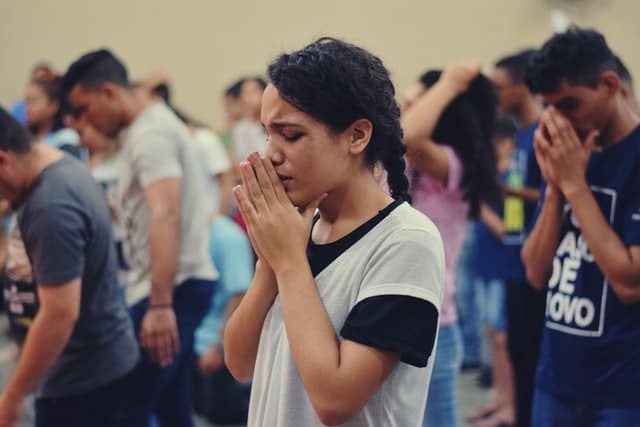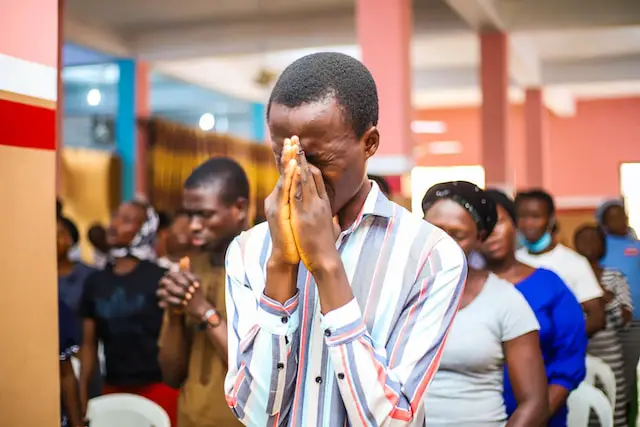When it comes to prayer, people practice many different types and styles. Every kind of prayer has its unique meaning and purpose and can be used to connect with a higher power or seek guidance and support in times of need.
Understanding the different types of prayer and their meanings can help you deepen your spiritual practice and find greater peace and clarity in your life.
One of the most common types of prayer is known as petitionary prayer. This prayer involves asking a higher power for something, such as healing, guidance, or protection.
Petitionary prayer can be a powerful tool for those who believe in the power of prayer, as it allows you to connect with a higher power and ask for help in specific areas of your life.
Another type of prayer is known as intercessory prayer, which involves praying on behalf of others. This type of prayer can be a way to show love and support for others and can also help to bring about positive change in the world.
Table of contents
Understanding Prayer

Definition and Purpose
Prayer is a form of communication with a higher power, often seen as a way to connect with God or a divine being. It is a way to express gratitude, ask for guidance, and seek forgiveness. Prayer can take many forms, including spoken words, silent thoughts, and physical actions.
The purpose of prayer varies among different religions and individuals. Some pray to seek blessings and protection, while others pray for strength and courage. Prayer can also be used as a meditation to help calm the mind and reduce stress.
Historical Perspectives
Prayer has been a part of human history for thousands of years, with evidence of prayer found in ancient civilizations such as Egypt, Greece, and Rome. In many cultures, prayer was seen as a way to communicate with the gods and seek their favor.
In Christianity, prayer is a way to connect with God and seek forgiveness for sins. The Lord’s Prayer is a well-known example of a Christian prayer that is recited by many.
In Islam, prayer is one of the Five Pillars and is performed five times daily to connect with Allah and seek guidance. Muslims also recite the Qur’an as a form of prayer.
In Buddhism, prayer is seen as cultivating compassion and wisdom. Buddhists often recite mantras or chants as a form of worship.
Overall, prayer is a universal practice used by people of different faiths and cultures throughout history. It is a way to connect with a higher power and seek guidance, strength, and peace.
Forms of Prayer

When it comes to prayer, there are different forms that you can use to communicate with your higher power. Two of the most common forms of worship are silent and spoken.
Silent Prayer
A silent prayer is a form of communicating with your higher power through your thoughts. This type of prayer is usually done in a quiet and peaceful environment, where you can focus on your intentions and desires.
Silent prayer is a great way to connect with your inner self and to find guidance from your higher power.
Spoken Prayer
Spoken prayer is a form of communication with your higher power through spoken words. This type of prayer is usually done out loud and can be done alone or with a group.
Spoken prayer is a great way to express your gratitude, ask for forgiveness, or make requests to your higher power. It can also be a way to connect with others and to share your intentions and desires with like-minded individuals.
Both silent and spoken prayer have unique benefits and can be used in different situations. Finding the form of worship that resonates with you the most is essential, and using it consistently to deepen your connection with your higher power is necessary.
Prayer in World Religions

Prayer is an essential part of many world religions. It is a way for individuals to connect with their higher power and express their gratitude, hopes, and concerns. Here are some examples of prayer in different religions:
Christianity
In Christianity, prayer is a way to communicate with God and ask for forgiveness. It is also a way to express gratitude and ask for guidance. Christians often pray in church, at home, and before meals.
Islam
In Islam, prayer is called Salah and is performed five times daily. It is a way for Muslims to connect with Allah and show devotion. Muslims face Mecca when they pray and recite verses from the Quran.
Hinduism
In Hinduism, prayer is called Puja and is performed at home or in a temple. It involves offering flowers, food, and other items to a deity and reciting mantras. Hindus believe prayer can bring them closer to their chosen God and help them achieve their goals.
Buddhism
In Buddhism, prayer is called Dharma and is often performed in a group setting. Buddhists recite mantras and focus on their breath to achieve inner peace and mindfulness. They also offer prayers to the Buddha and other enlightened beings.
Judaism
In Judaism, prayer is a way to connect with God and ask for forgiveness. Jews pray three times daily and often use a Siddur prayer book. They also have special prayers for holidays and life events such as weddings and funerals.
Overall, prayer is an integral part of many world religions and serves as a way for individuals to connect with their higher power and express their spirituality.
Personal Prayers

Personal prayers are the most common type of prayer, and they are often used to express gratitude, ask for help, seek forgiveness, and make requests. Individuals usually offer these prayers, which can be done privately or publicly.
Gratitude
Gratitude prayers are offered to express appreciation for blessings received. They can be provided for good health, financial stability, success, or anything positive in your life. Gratitude prayers help you focus on the good things in your life and develop a positive attitude.
Supplication
Supplication prayers are offered to ask for help or assistance. They can be provided for physical healing, emotional healing, financial aid, or any other need. Supplication prayers help you acknowledge your limitations and seek help from a higher power.
Intercession
Intercession prayers are offered on behalf of others. They can be provided to family members, friends, or even strangers. Intercession prayers help you develop empathy and compassion for others and recognize that we are all connected.
Confession
Confession prayers are offered to seek forgiveness for sins or wrongdoings. They can be provided for personal sins or sins committed against others. Confession prayers help you acknowledge your mistakes and seek forgiveness and reconciliation.
In conclusion, personal prayers are a robust spiritual growth and development tool. They help you to connect with a higher power, develop gratitude and compassion, and seek forgiveness and help when needed. Incorporating personal prayers into your daily routine can create a more profound sense of peace, purpose, and meaning.
Communal Prayers

Communal prayers are said in a group setting, where individuals come together to offer their supplications.
These prayers can be conducted in various locations, including churches, mosques, synagogues, and other religious institutions.
Liturgical
Liturgical prayers are those that follow a set structure and format. These prayers are often recited in religious services and are led by a spiritual leader or clergy member.
The design of liturgical prayers varies depending on the religion and denomination. For example, in the Catholic Church, the liturgical prayers follow the Roman Missal, while in the Anglican Church, the Book of Common Prayer is used.
Non-Liturgical
Non-liturgical prayers are those that do not follow a set structure or format. These prayers are often spontaneous and can be said in groups or individuals. Non-liturgical prayers are often used in informal settings, such as prayer circles or small group gatherings.
Overall, communal prayers provide a sense of unity and community among believers. Whether liturgical or non-liturgical, these prayers offer an opportunity for individuals to come together and present their supplications to a higher power.
Special Intentions

When you pray with a specific intention, it is known as a particular intention. This type of prayer can be used for various purposes, such as seeking healing, guidance, or protection.
Healing
If you or someone you know is dealing with an illness or injury, you may want to offer a particular intention for healing.
This type of prayer can ask for physical, emotional, or spiritual healing. It is important to remember that prayer is not a substitute for medical treatment but a complementary practice that can help promote healing and well-being.
Guidance
When facing a difficult decision or feeling lost, a particular intention for guidance can help you find clarity and direction.
This type of prayer can be used to ask for advice from a higher power, whether it be God, the universe, or your inner wisdom. It can help you connect with your intuition and make decisions that align with your values and goals.
Protection
If you feel vulnerable or unsafe, a particular intention for protection can help you feel more secure and grounded.
This prayer can ask for protection from harm, negative energy, or unwanted influences. It can help you create a sense of safety and peace in your surroundings and can also be used to protect loved ones or other people in need.
Overall, special intentions can be a powerful tool for connecting with your spirituality and seeking support from a higher power. Whether seeking healing, guidance, or protection, prayer can help you find peace and comfort in difficult times.
Meditative Practices

Contemplative Prayer
Contemplative prayer is a form of prayer that involves silent reflection and meditation on a specific word or phrase. This type of prayer is often associated with the Christian tradition and is used to deepen one’s relationship with God. Contemplative prayer involves focusing on a word or phrase and repeating it slowly and deliberately, allowing the mind to become quiet.
Contemplative prayer is a powerful tool for spiritual growth and can help you develop a more profound sense of peace and inner stillness. It can also help you connect with your inner self and better understand your place in the world.
Centering Prayer
Centering prayer is similar to contemplative prayer but involves a deeper level of stillness and silence. This type of prayer is often associated with the Christian contemplative tradition and consists of sitting quietly and focusing on a specific word or phrase.
Centering prayer aims to enter into a state of deep inner stillness and silence, where you can connect with the divine presence within. This type of prayer can be challenging at first, but it can become a powerful tool for spiritual growth and transformation with practice.
Meditative practices like contemplative and centering prayer can be powerful tools for spiritual growth and transformation. By quieting the mind and connecting with the divine presence within, you can deepen your relationship with God and gain a greater sense of peace and inner stillness.
The Impact of Prayer

Prayer is a powerful tool used for centuries to connect with a higher power or express gratitude. The impact of prayer can be felt on an individual and societal level, with different types of prayers yielding different results.
On the Individual
Prayer can profoundly impact an individual’s mental, emotional, and physical well-being. It can provide comfort, peace, and hope during difficult times and help reduce stress and anxiety. Prayer can also help individuals feel more connected to their faith or spirituality, providing a sense of purpose and meaning in life.
Different types of prayers can have other effects on the individual. For example, gratitude prayers can help cultivate a positive mindset and increase feelings of happiness and contentment. Prayers of supplication can help individuals feel more empowered and in control of their lives, while prayers of confession can provide a sense of release and forgiveness.
On Society
Prayer can also have a significant impact on society as a whole. It can bring people together and promote a sense of community and unity. Prayer can also promote peace and harmony and help reduce conflict and violence.
Different types of prayers can have other effects on society. For example, prayers for peace can help to promote understanding and cooperation between other groups, while prayers for justice can help to bring about positive social change. Prayers for healing can also have a powerful impact on society, as they can promote empathy and compassion for those suffering.
In conclusion, the impact of prayer is far-reaching and can have both individual and societal benefits. By understanding the different types of prayers and their meanings, individuals can harness prayer’s power to improve their lives and the world around them.
Challenges and Misconceptions

When it comes to prayer, people often encounter a few challenges and misconceptions. Here are some of the most common ones:
1. Feeling Like Your Prayers Aren’t Being Answered
One of the biggest challenges people face when it comes to prayer is feeling like their prayers aren’t being answered. This can be incredibly discouraging when you’re going through a difficult time and need guidance or support.
However, it’s important to remember that just because you don’t get the answer you were hoping for doesn’t mean your prayers aren’t being heard. Sometimes, the answer we receive is not the answer we want but the answer we need.
2. Believing That Prayer Is Only for Religious People
Another common misconception about prayer is that it’s only for religious people. However, regardless of their beliefs, prayer can be a powerful tool for anyone.
Whether seeking guidance, comfort, or just a moment of peace, prayer can help you connect with something greater than yourself and find the strength to face life’s challenges.
3. Thinking That You Have to Pray in a Certain Way
Many people believe there is a “right” way to pray and that their prayers won’t be effective if they don’t follow specific rules or guidelines.
Also, the truth is that there is no one “right” way to pray. Whether you pray silently, out loud, in a group, or alone, what matters most is that you are sincere and open to receiving guidance and support.
4. Assuming That Prayer Is Always About Asking for Something
Finally, another common misconception about prayer is that it’s always about asking for something. While it’s true that many people use prayer to ask for guidance, support, or blessings, prayer can also be a way to express gratitude, offer thanks, or connect with something greater than yourself.
By approaching prayer with an open mind and heart, you can discover its many benefits and deepen your spiritual practice.
Modern Perspectives on Prayer

In today’s world, prayer takes on many different forms and meanings. Many people view prayer as connecting with a higher power, while others see it as meditation or self-reflection. Here are some modern perspectives on prayer:
- Mindfulness meditation: This type of prayer involves focusing on your breath and being present in the moment. It can help reduce stress and anxiety and improve overall well-being.
- Gratitude prayer: This type of prayer involves expressing thanks and appreciation for the blessings in your life. It can help cultivate a positive attitude and increase feelings of happiness.
- Intercessory prayer: This type of prayer involves asking for help or guidance from a higher power. It can provide comfort and support during difficult times.
- Contemplative prayer: This type of prayer involves reflecting on a particular idea or concept, such as love or forgiveness. It can help deepen your understanding of yourself and others.
Whatever type of prayer you choose can be a powerful tool for personal growth and spiritual connection. By reflecting and connecting with a higher power, you can find peace and clarity in your life.
